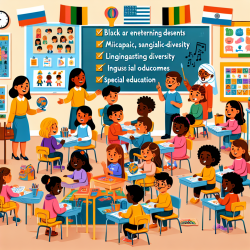In today's educational landscape, the diversity of student populations is more pronounced than ever before. Classrooms across North America are vibrant tapestries woven from various cultural and linguistic threads, each contributing its unique hue to the educational experience. As educators, it is imperative to embrace this diversity, not as a challenge to overcome, but as an opportunity to enrich the learning environment for all students. Drawing insights from the research presented in "Meeting the Needs of Culturally and Linguistically Different Students: A Handbook for Educators," this blog aims to equip practitioners with strategies to enhance their skills in supporting diverse learners and encourage further exploration into this crucial area of education.
The handbook serves as a comprehensive guide for educators, administrators, special educators, and speech-language pathologists, offering practical advice on developing and implementing programs that effectively serve culturally and linguistically diverse (CLD) students. It emphasizes a proactive approach, advocating for the creation of educational environments that not only acknowledge but celebrate and leverage the unique backgrounds of all students.
One of the foundational steps in meeting the needs of CLD students is establishing a robust data base that captures detailed information about students' linguistic abilities and academic achievements. This data serves as a critical tool for identifying needs, monitoring progress, and tailoring instruction to maximize learning outcomes. Educators are encouraged to adopt technologies, such as computer-based systems, to streamline data management and ensure that every student's journey is meticulously documented and reviewed.
Program goals should be set with a keen focus on inclusivity, ensuring that the needs of students who are both Limited English Proficient (LEP) and those with disabilities are comprehensively addressed. The handbook underscores the importance of integrating bilingual and special education services, fostering a collaborative environment where professionals from various disciplines work together to support the holistic development of CLD students. It also highlights the critical role of professional staff training in building a knowledgeable and sensitive educational team capable of navigating the complexities of cultural and linguistic diversity.
Assessment strategies for CLD students require careful consideration to avoid the pitfalls of standardized measures, which may not accurately reflect the abilities of students from diverse backgrounds. The handbook advocates for the use of informal assessment strategies that are culturally and linguistically responsive, ensuring that evaluations are fair, comprehensive, and reflective of students' true capabilities.
Creating learning environments that are conducive to the success of CLD students involves embracing collaborative and cooperative learning strategies. These approaches not only support academic achievement but also foster social integration, mutual respect, and understanding among students from different backgrounds. Educators are encouraged to design activities that promote interaction and collaboration, allowing students to learn from one another and develop a deep appreciation for diversity.
Family involvement is another critical component of supporting CLD students. The handbook offers strategies for engaging families in the educational process, recognizing that parents and guardians are invaluable partners in their children's learning journey. Efforts should be made to bridge cultural gaps, communicate effectively with families, and encourage their active participation in school activities.
Finally, the handbook emphasizes the importance of ongoing program evaluation, involving professional team leaders and the community in assessing the effectiveness of educational initiatives. This collaborative approach ensures that programs remain responsive to the needs of CLD students and are continuously refined to better serve this population.
In conclusion, "Meeting the Needs of Culturally and Linguistically Different Students: A Handbook for Educators" offers a wealth of knowledge and practical strategies for educators committed to fostering inclusive, supportive, and effective learning environments for all students. By embracing the principles outlined in this handbook, practitioners can significantly enhance their skills and make a meaningful impact on the educational outcomes of culturally and linguistically diverse learners. For those interested in delving deeper into this critical topic, further exploration and research are highly encouraged.
To read the original research paper, please follow this link: Meeting the Needs of Culturally and Linguistically Different Students: A Handbook for Educators.










